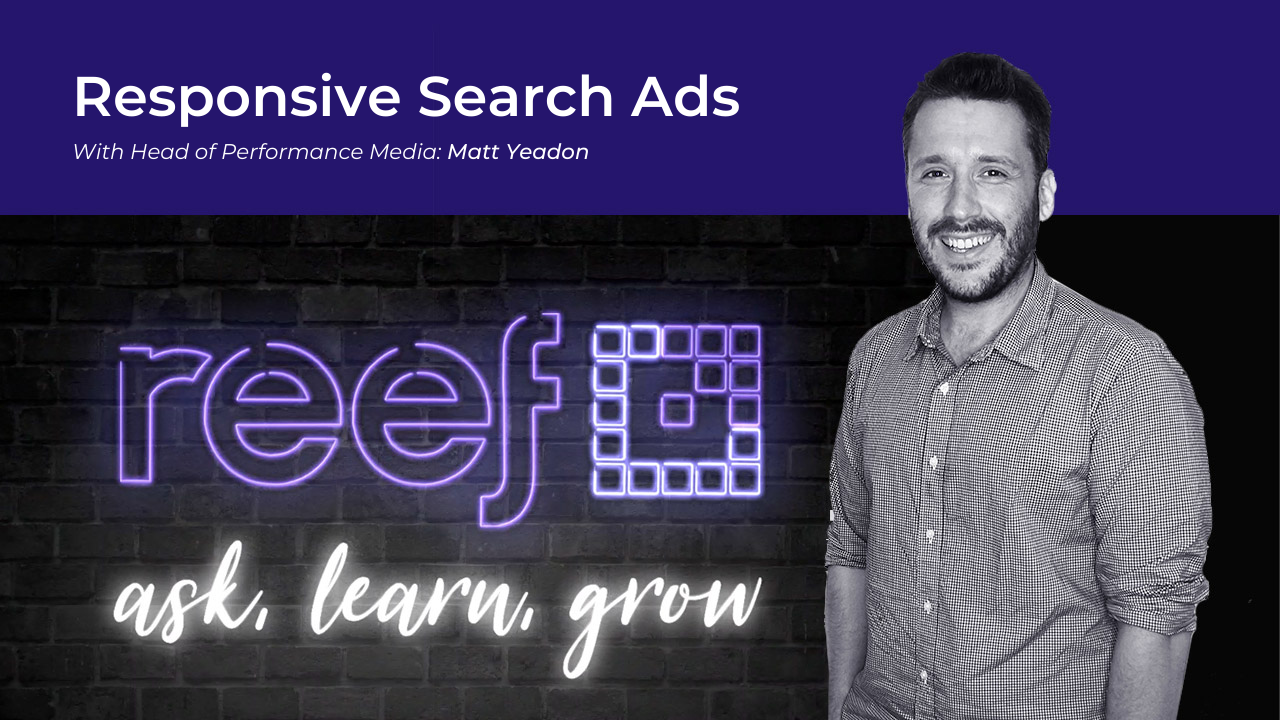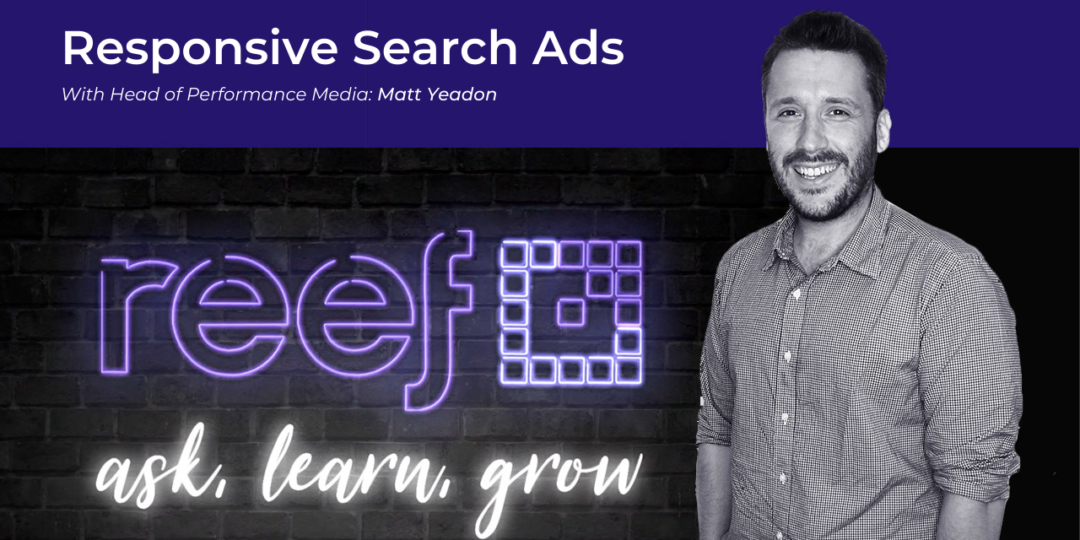Scott:
Hi, everyone. Welcome to another episode of Ask Learn Grow, the show where the Reef team answer questions and share updates and insights from the digital marketing industry.
I’ve got Head of Performance Media, Matt Yeadon, with me today and we’re going to be continuing the discussion about Google Ads.
Today we’re talking about Responsive Search Ads. This builds on the topic of machine learning, which we’ve been discussing in some of our recent videos.
So Matt, can you start by explaining what Responsive Search Ads actually are for those who might not be aware of them?
Matt Yeadon:
Yeah. So they’re a fairly recent addition to Google Ads, recent as in the last 12 months or so, but Google have been pretty adamant about getting every account to start using them.
In the past when writing ad copy, we’d write ad copy that’s unique to each ad, so each headline and description were together as a single unit.
From there, we would test the ad copy units against one another and determine what the highest performing messaging was.
We’d then combine it with features such as ‘optimise for best performing’, where Google would then select the best ad copy to show based on things like click through rate, ad relevancy and conversion rate.
So when Responsive Search Ads came along, they kind of shook up the game a little bit. They’re a little bit different.
So rather than structuring our ad copy as single units made up of a single headline and description, we provide multiple headlines and multiple descriptions to run as one unit.
So for example, we might provide 10 headlines, 4 description lines, and then we let Google’s algorithm work out what the best combination of these variations are.
Google will then chop and change the headlines and descriptions and test them against one another using machine learning.
Where it’s interesting though is in how they actually go about doing that.
Rather than looking at things like click through rate, conversion rate, ad relevancy etc, it also takes into consideration the user who’s actually viewing that ad. This is a key difference to the way standard ad copies worked in the past.
Scott:
Okay, sounds interesting. Can you explain a little bit more about how they actually work, more the mechanics of it?
Matt Yeadon:
Yeah. So, like I said, you give them 10 headlines and 4 description lines to work with.
The way they actually optimise that I alluded to, is a little bit different.
You can think about it like this: The messaging that resonates with you might not exactly be the same messaging that resonates with me.
So Google is taking that into account and what they’re looking at, it almost sounds scary to say, but they’re analysing up to 7 million user data points each month.
This could be signals from people across Google Search, YouTube, places you’ve visited, things you do on your phone, what kind of pages you like…
It’s a huge amount of information that they’re using, and what they’re really looking for is the kind of messaging that will resonate with you as a user.
Based on this, they will try to show you the optimal combination of headline and description so you see – I know it’s an overused term in the industry but – the right ad at the right time.
They’ll show you the ad that you’re most likely to resonate with.
So the way they go about doing that is they look at other users who are similar to you. So other users who give off fairly similar signals on a weekly or monthly basis, also taking into account recency and frequency.
They then use that data to help determine the best ad to show to you at the right time.
In the past the way we would run with Expanded Text Ads, was to write the different sets of ad copy and then test them against one another.
Now, with Responsive Search Ads, we’re actually taking the user into consideration and more about who the searchers actually are.
Scott:
Why should you use Responsive Search Ads?
I take it the goal is to improve performance while reducing some of the manual load associated with a solid ad copy testing plan?
What’s your experience and why would somebody want to use Responsive Search Ads in their campaign?
Matt Yeadon:
They’re really useful at rapidly determining what messaging works and importantly what messaging doesn’t work.
They allow us to tap into all the information Google has on its users that isn’t necessarily available to us as marketers.
So we can tap into those seven million signals without really knowing anything about what those signals are and use Responsive Search Ads to optimise and test using that data set.
They’re also a really great addition to run alongside regular search ads because you can test messaging rapidly.
You can enter several headlines and relatively quickly with enough traffic, start to get a good idea of what messaging is really working and what isn’t.
You can then incorporate that into your standard text ads as well because standard text ads are still vital. You still need to be running those in the account. But responsive search ads allow you to tap into the additional machine learning layer, that hasn’t been available in the past in this way.
Scott:
From using Responsive Search Ads, have you seen that performance has generally been good or better and are they worth using?
Are there any pitfalls or things that people should be aware of?
Matt Yeadon:
Yeah. So we’ve seen with Responsive Search Ads, you usually see an uplift in click through rates.
I wouldn’t expect a massive uplift in click through rates, but you definitely do see an improvement.
You might notice anywhere up to about 5-10% of a lift in overall click through rates when you’re running Responsive Search Ads versus standard text ads.
The other benefit they have is, Google have what they call the OptiScore, built into all accounts.
Performance Media Manager, Andrew Tan talks more about the OptiScore in the video below:
By using Responsive Search Ads, you can actually improve your OptiScore for your Google Ads account. This can, it’s not confirmed, but it can have a positive impact on your overall ads account.
So they’re definitely worth running. But overall, we do tend to see a nice uplift in click through rates, usually between 5-10% when we’re utilising them.
Scott:
Are there any downsides, things to be aware of or watch out for when you start working with Responsive Search Ads?
Matt Yeadon:
So, for us, because we run the single keyword ad group model (SKAG), there is an option in the recommendations tab, which allows you to automatically build the Responsive Search Ads.
It will just grab all your headlines and description lines and kind of dump them all together.
When that wouldn’t work is if you run SKAGs and put the keyword in the headline, in headline one typically.
That kind of breaks when a user’s not searching for that keyword, but that keyword might show up, which can have a negative impact on ad relevancy.
So this is something you need to keep in mind.
If you’re running single keyword ad groups, what you can do is actually pin your headlines.
So we tend to pin all of the headline ones to ensure they remain relevant to the keyword. Then you can provide up to 10 inputs for headline two, three, and then the four inputs for description lines.
So that’s definitely pitfall number one.
Pitfall number two is, you can’t easily measure which headlines are actually performing the best.
The way Google export the data is just in a big Excel sheet that you’ve got to then work with.
It doesn’t really give you a granular breakdown of which messaging is actually working, which can be frustrating.
So that’s where your standard text ads come in.
So you can test with your standard text ad, see which ones are working, see which ones are the best, and then add them into your Responsive Search Ads.
Then finally, because they’re chopping and changing the headlines, sometimes you might have some clients who need to comply with certain regulation.
They might have to have some sort of disclaimer or certain language in their ads which always needs to be taken into consideration.
So again, recommend that you pin those headlines in this instance, otherwise Google will just chop and change the inputs and you might end up with messaging that’s in breach.
So there are definitely some pitfalls that you need to be aware of when running Responsive Search Ads.
Scott:
When you say, “Pin the headline.” Does that mean Google will always use that headline and chop and change the descriptions?
Matt Yeadon:
Yep. So you can pin it in place.
You can always say, “I just want [this] to be in headline one, nothing else.”
Then the other ones you can chop and change and do whatever you want with.
Scott:
Good, so there’s a degree of control in there as well?
Matt Yeadon:
Yeah. In the past, when it first came out, there wasn’t. Not surprisingly, we were pretty sceptical about using them without this, but they’ve improved a lot over the past 12 months or so.
Scott:
So you’d definitely recommend adding this to your campaign mix and testing?
Matt Yeadon:
Yeah.
Run one Responsive Search Ad per Ad Group, and a minimum of three standard text ads.
That’ll also help to boost your Google OptiScore too.
Scott:
Great stuff. Thanks for sharing that information, Matt and covering Responsive Search Ads in detail on this call.
If you’ve got any questions about Responsive Search Ads or any digital marketing related topic, we’re always happy to help so do send those in.
If you’d like to put a burning question to the team to answer in one of the future videos, send those in too, and we’ll see what we can do.
Don’t forget to subscribe to the channel to be notified of when the next video is available.
Thanks Matt, thanks all for watching and enjoy the rest of the day.

